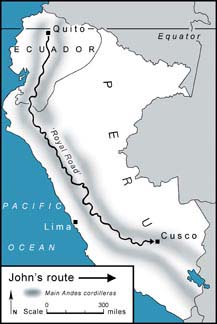
![]() Royal Road intro – First update – Previous update – Next update – Final update – Come to a talk!
Royal Road intro – First update – Previous update – Next update – Final update – Come to a talk!
Before reaching Cusco I couldn’t resist making a detour from the Royal Road to perhaps the greatest Inca achievement of them all, Machu Picchu. From the village of Mollepata I turned north, climbing to 16,000 feet under the face of Salkantay, the sacred mountain of the Incas, an almost perfect pyramid whose snowfields glowed crimson in the setting sun. The most common approach to Machu Picchu is from below, but anyone who walks there will first glimpse it from a dramatic high point known as Intipunku, ‘Gateway to the Sun’. I arrived at this spot just as the first rays of morning were touching the hilltops. There at my feet stood the extraordinary city, embracing a saddle beneath the sugar-loaf profile of Huayna Picchu, its terraces spilling down to where the steeply sloping hillside finally gave way to 1,500-foot cliffs.
The tens of thousands of photographs taken from Intipunku do nothing to prepare you for this first sighting. Rediscovered a century ago by the American archaeologist Hiram Bingham, Machu Picchu’s plazas, temples and stairways have been painstakingly restored and on the outer slopes work is still going on. Bingham thought he had found Vilcabamba, the Inca’s legendary final hiding place after his defeat by the Spanish. Although this has now been disproved, Machu Picchu certainly served as a refuge in the years following the conquest – probably the most impregnable fortress the world has ever seen. In fact Pizarro’s men never found it.
I was now just two days from Cusco and the end of the walk. I rejoined the Royal Road at Zurite and struck out across the Plain of Anta, where in 1533 the city’s defenders made their last desperate stand against the advancing conquistadores. At that time the road crossed this swampy expanse on a raised causeway, but now only its flanking ditches remain. The land has been drained and is grazed by a most un-Inca animal, the cow, source of the delicious cheeses they sell in Cusco’s Santa Ana market.
Beyond the village of Anta the road disappeared completely, and I followed a narrow-gauge railway up to the final low pass. The approach gave surprisingly little warning of the city ahead. I passed through eucalyptus groves dotted with adobe huts, red-brown, the colour of the earth. Children ran semi-naked, pigs nosed in the dirt. Across the valley the modern paved highway hummed with traffic, but that was all.
Suddenly I was at the summit. The railway passed through a crumbling archway and there, filling the valley ahead, was my final destination. Pizarro’s first glimpse was of a city on fire, torched by its retreating inhabitants. Mine was of a sprawling urban expanse stretching into the misty distance. Cusco is Peru’s fourth largest city and has doubled in size in the last 50 years; but the historic core has been well preserved. I could see it now, its colonnaded shops and grand churches huddled round the Plaza de Armas – Pizarro’s fortified central square. The scene looked thoroughly Spanish but I knew that the foundations of those buildings were Inca, and from where I stood the sea of red-tiled roofs was dominated by the vast, glowering Inca hillfort of Sacsayhuamán.
I strolled down the hill and made my way through cobbled streets, trying to absorb the clamour of South America’s number one tourist destination. After eight months in the wilderness it was too much. I lugged my rucksack across the Plaza de Armas and sought refuge in the Cathedral, its huge brass-studded doors thrown open to reveal a priest taking a candlelit mass. On the brink of the hushed interior I felt a tap on my shoulder and a voice in my ear. “Six dollars entrance please.”
I was back in the modern world.
